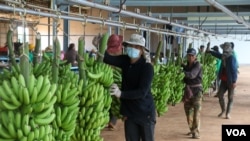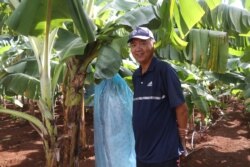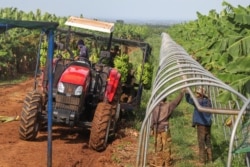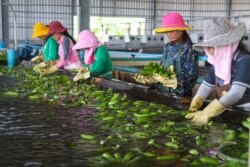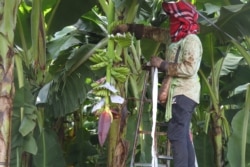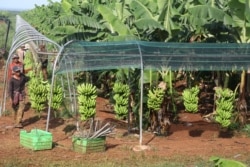Cambodia’s eastern border is rich in basaltic red soil that sustains large rubber plantations in Tboung Khmum, Kampong Cham, Kratie, or Ratanakkiri. It is not unusual to have a rubber plantation run along national roads for kilometers, with some of these estates dating back to the French colonial period.
The clay loam also supports the cultivation of bananas. And in Tboung Khmum’s O’Reang Euv district there is a small banana plantation surrounded by decades-old rubber trees. Chinese national Chen Zhiqang rides his motorcycle through the seemingly infinite rows of rubber trees to reach the 200-hectare banana plantation.
Chen Zhiqang arrived in Cambodia in 2016 to partner with prominent tycoon An Mady to carve out the banana plantation from the latter’s 3,600-hectare rubber plantation, which was granted as an economic land concession in 2008, according to government records.
Mature rubber trees were cut down to make way for the banana production facility, said Chen Zhiqang, to feed China’s high demand for the fruit.
“Banana is currently under-supplied in China,” said Chen Zhiqang standing in the plantation. “Chinese people like consuming bananas [so much] that I had to come to a foreign country like Cambodia to invest in this farm and export it back to China.”
The plantation will likely be in line to take advantage of a recent free trade agreement recently penned by Cambodia and China. The agreement will be signed in the next few weeks and will have zero tariffs on 95 percent of 340 approved products, including fruits.
A few other products like rice, rubber, tobacco will continue to have quotas, according to the Cambodian government’s announcements on the FTA.
The FTA comes as Cambodia will lose partial tariff-free access to European Union markets. The revocation of the ‘Everything But Arms’ privileges is on account of the country’s deteriorating human rights record.
Cambodia has looked to pitch the FTA with China as a counterbalance to the EBA loss, but experts have said drops in major Cambodian exports like garments and footwear are unlikely to be absorbed by the Chinese.
“Whether our great friend of China is signing this agreement to offset our partial loss of EBA is up to your judgment,” said Sok Sopheak, a secretary of state at the Commerce Ministry, declining to comment further at a recent press conference.
The two countries reported around $8 billion in trade in 2019, with Cambodia registering a large trade deficit because it exported only a little more than $1 billion to China last year, most of which was rice exports. Cambodia has said the new FTA will help increase its export potential, even though it is unlikely Chinese imports of raw materials for manufacturing and construction will drop.
Prime Minister Hun Sen has placed his bets on agriculture exports, using his last three public appearances to tout the traditional role and importance of Cambodian farmers. This talk about increasing agribusinesses has given investors like Chen Zhiqang the opportunity to build on the 2018 agreement that first formalized banana exports to China.
According to the Agriculture Ministry and Chinese Embassy statistics, there are 21 banana packaging plants in Cambodia, servicing roughly 8,000 hectares of plantations. While the ministry has not provided a country-specific breakup of exports, it said a large portion of the 160,000 tons of bananas exported for the first seven months of 2020 headed to China.
The increase in banana cultivation and exports has also signaled a shift away from the traditional cash crop of rubber, a mainstay of Cambodia and foreign agribusinesses based in the country for decades.
A few hours’ drive from Tboung Khmum, another tycoon, Heng Long, has similarly repurposed 1,000 hectares of his rubber economic land concession in Kampong Cham province to grow bananas. He was granted a 7,300-hectare land concession by the government for rubber plantations.
The businessman is candid about how expecting profits from rubber exports was futile, adding that it made business sense to divest from the commodity. There is an image of Heng Long standing in a rubber plantation from the early 2000s behind his desk at his company’s headquarters in Phnom Penh.
“If you keep growing rubbers there can be only two results: loss or you break even,” said Heng Long at the Long Sreng International headquarters in Phnom Penh.
He said bananas were a more profitable option, which is why he tied up with a Chinese investor from Guangxi province in 2018 at an initial investment of $20 million.
“If we kept relying on rubber, we would not even be able to pay the workers’ wages that our company is envisioning a future in bananas because it has an emerging market demand with a very good price,” Heng Long told VOA Khmer.
Agriculture Ministry spokesperson Pol Sopha confirmed that there was a shift away from rubber to other commodities, claiming that rubber production was stable despite the increased cultivation of bananas and other products in rubber-producing areas.
“We are not strict on allowing only the rubber plantation,” said Pol Sopha, who also heads the ministry’s rubber department. “We need to catch up accordingly with the latest economic trends and market potentials with other crops.”
Former Cambodian Foreign Minister Hor Namhong, who co-heads the Cambodian-Chinese Intergovernmental Coordinating Committee with Chinese Foreign Minister Wang Yi, said at a press event on July 23 that China would back the Cambodian government’s hurried shift back to agriculture, given that tourism and garment industries were unlikely to recover soon from the COVID-19 pandemic.
“China had previously said they would support Cambodia in accordance with China’s own [capability],” Hor Namhong told reporters at the Office of Council of Ministers on July 23. “But China now says it will help Cambodia with what Cambodia needs.” “This is highly meaningful.”
But others are skeptical. Yang Saing Koma, a prominent agriculturist, said the agriculture sector has been lagging for a long time that it was unlikely to bridge the trade deficit.
“A free trade agreement is not a magical medicine to answer everything that has gone wrong in Cambodia’s agriculture sector,” he told VOA Khmer.
“It can be a medicine or a poison if we do not have complete knowledge of what we can readily export to China.”
Back in Tboung Khmum, Chen Zhiqang said he was hoping the increased sales from an FTA would help him scale up to 2,000 hectares and employ at least 4,000 workers.
For the time being, he was relying on the bonhomie between China and Cambodia to move ahead with his business decisions.
“I decided to come here because of a good Sino-Cambodian relation,” he said. “The good relations date back to the rule of late King Sihanouk and now our friendship gets even stronger when China expands its Belt and Road Initiative.”




